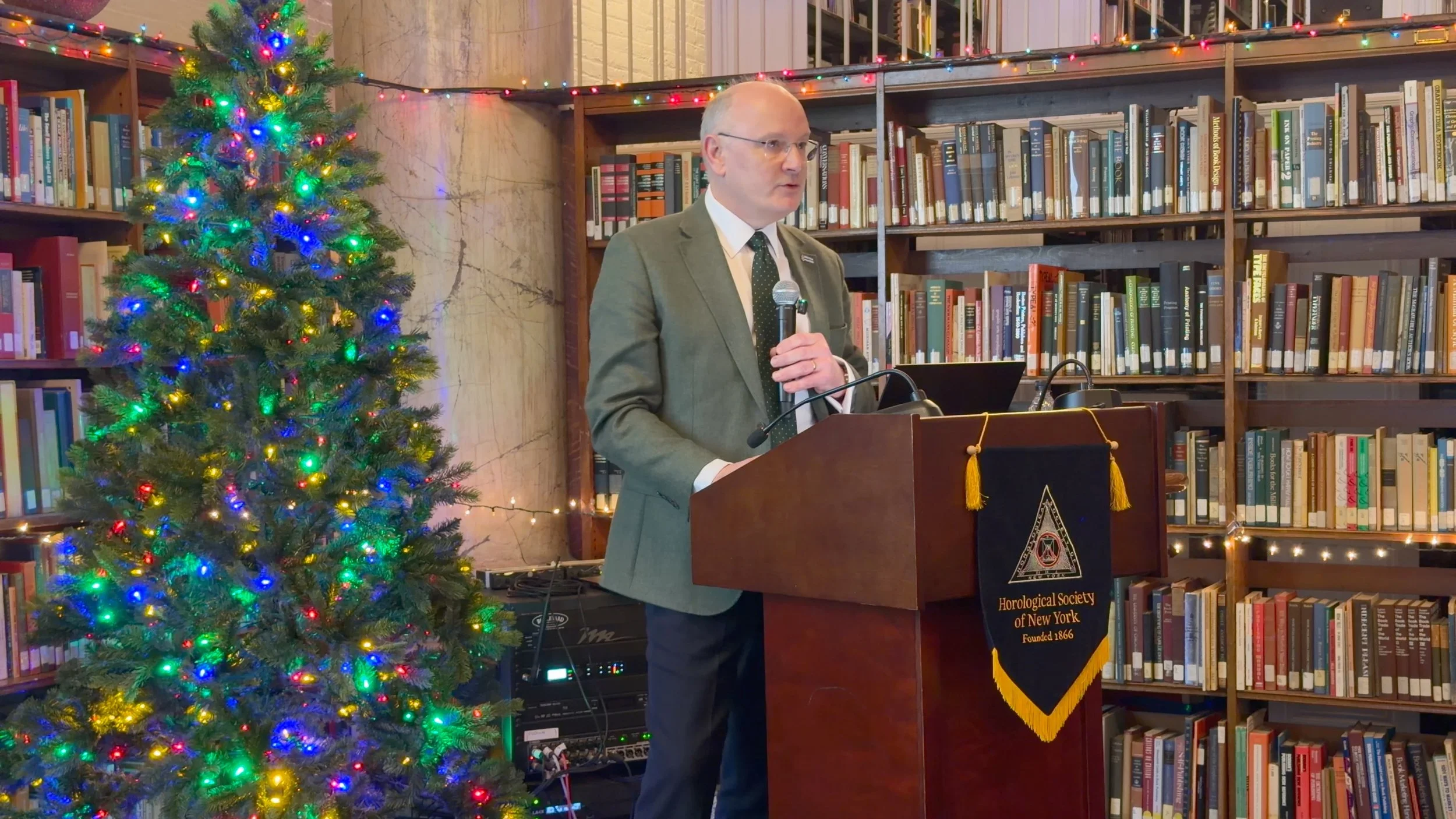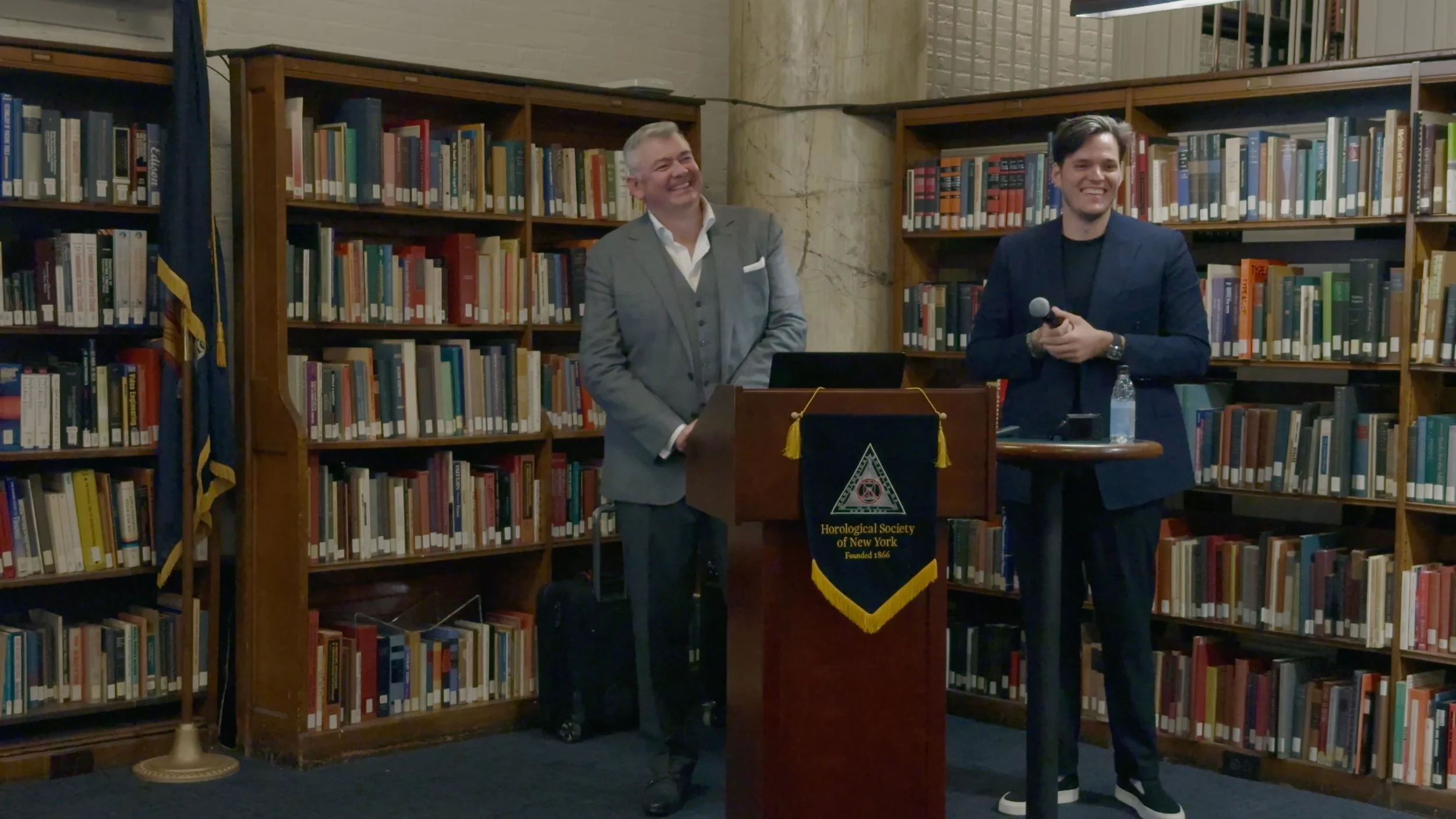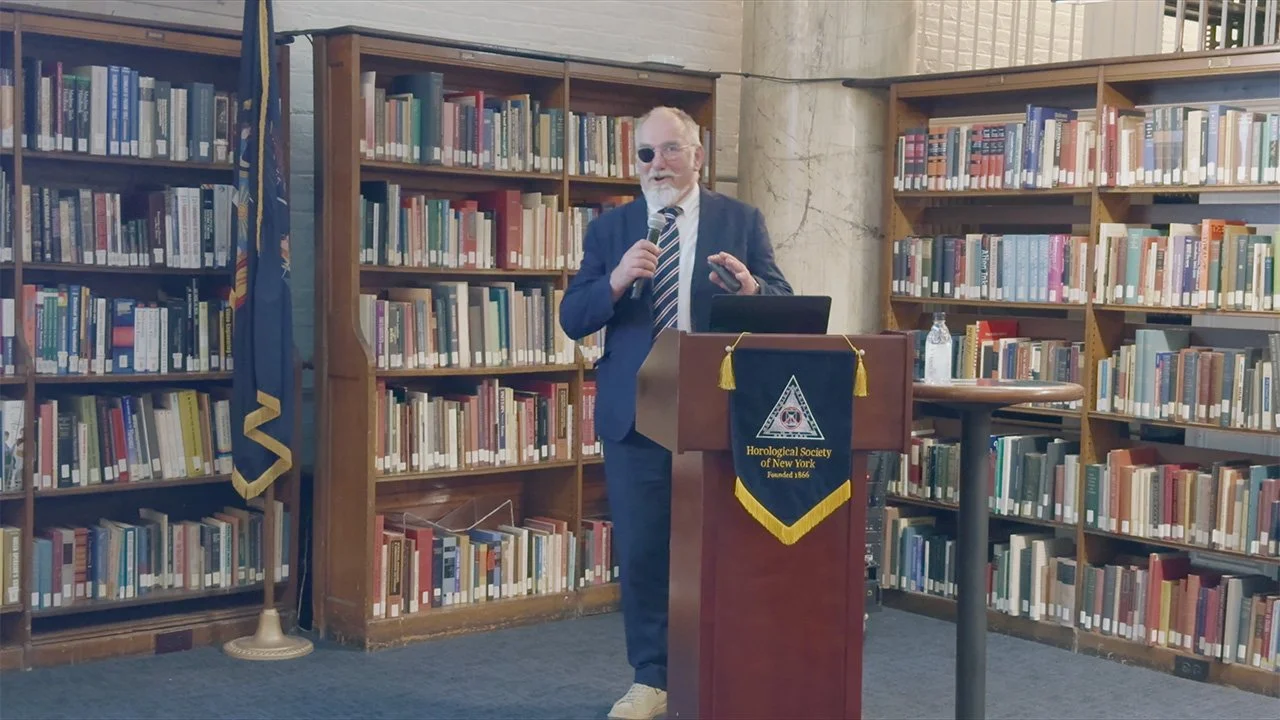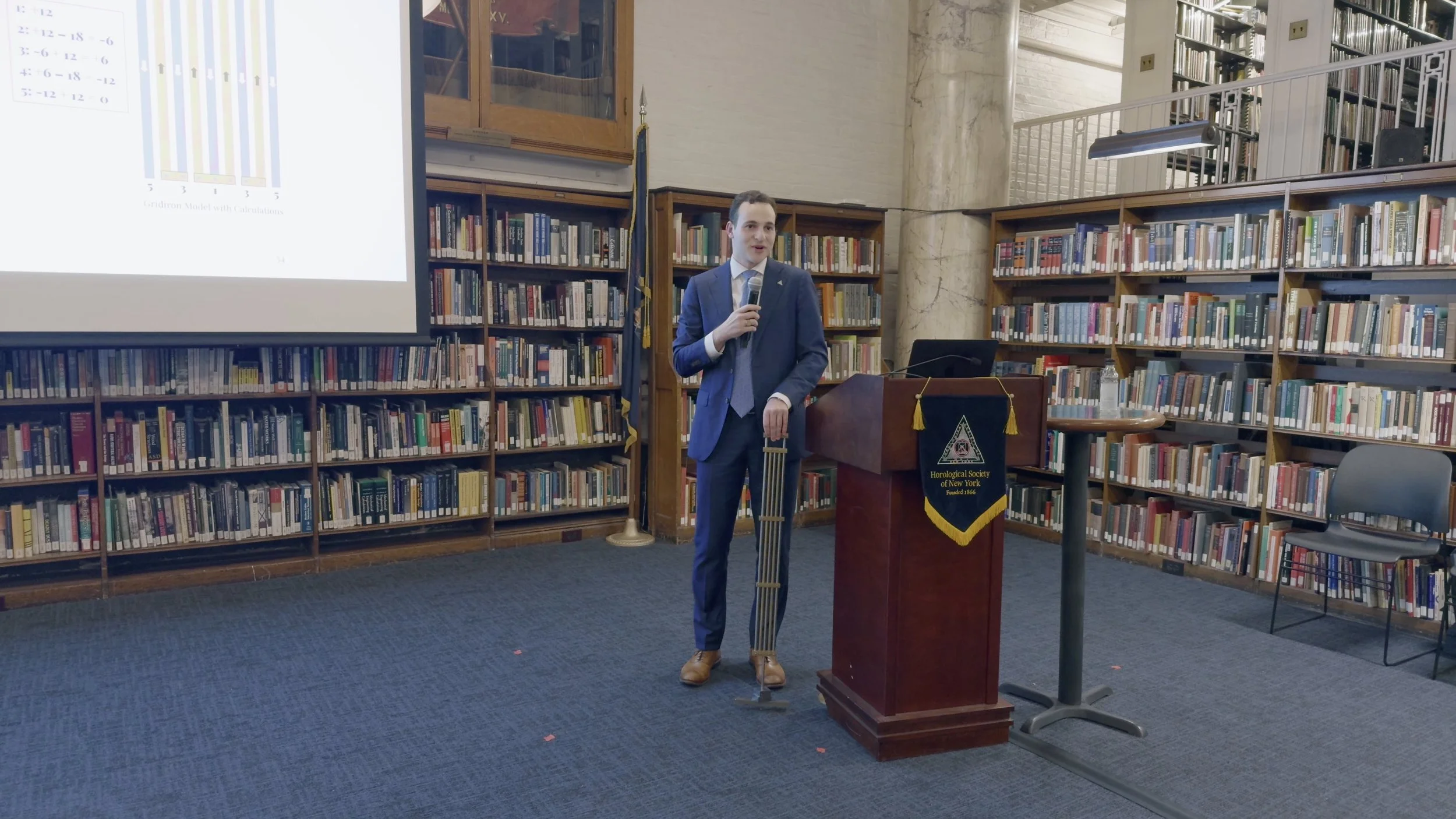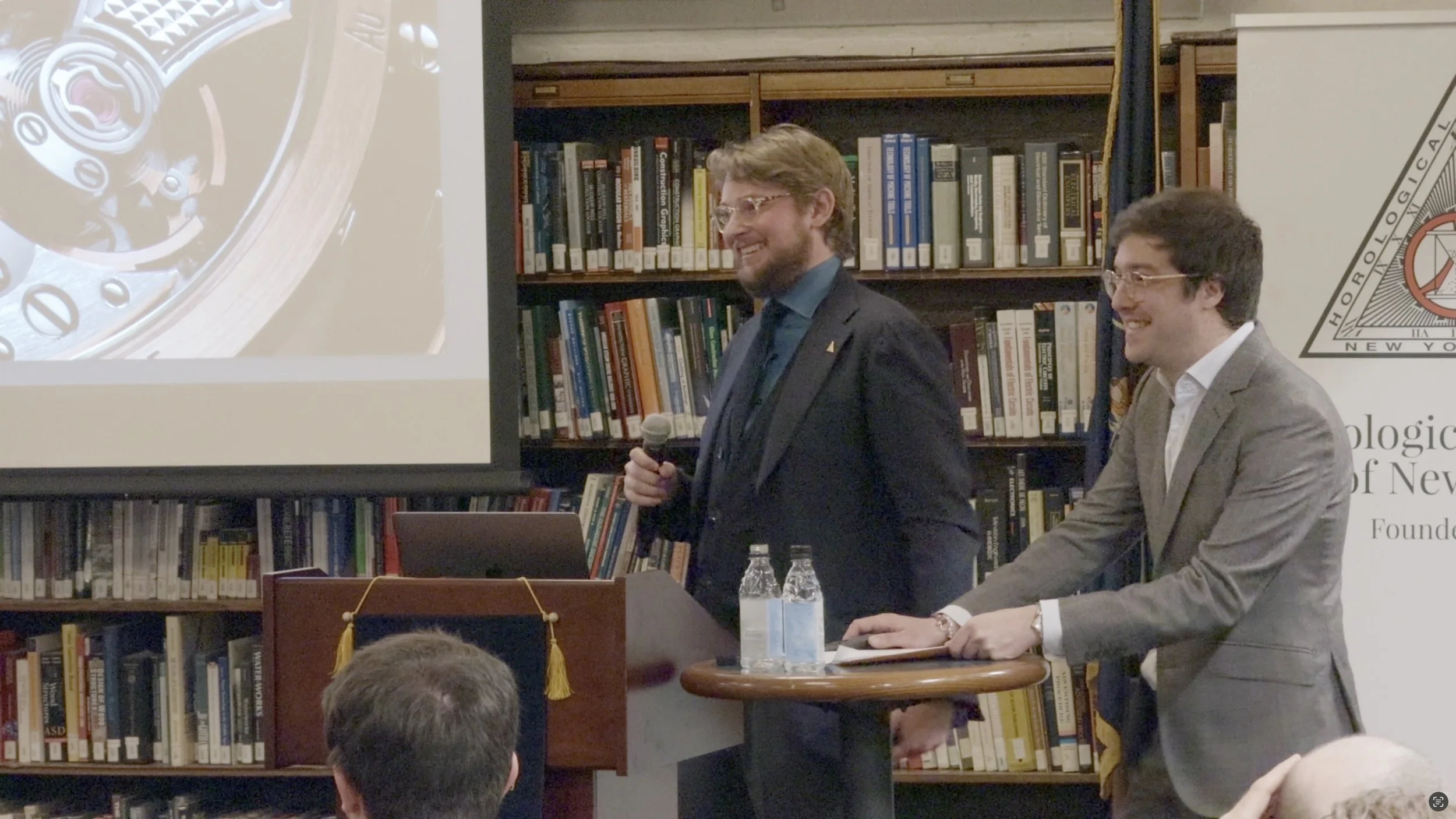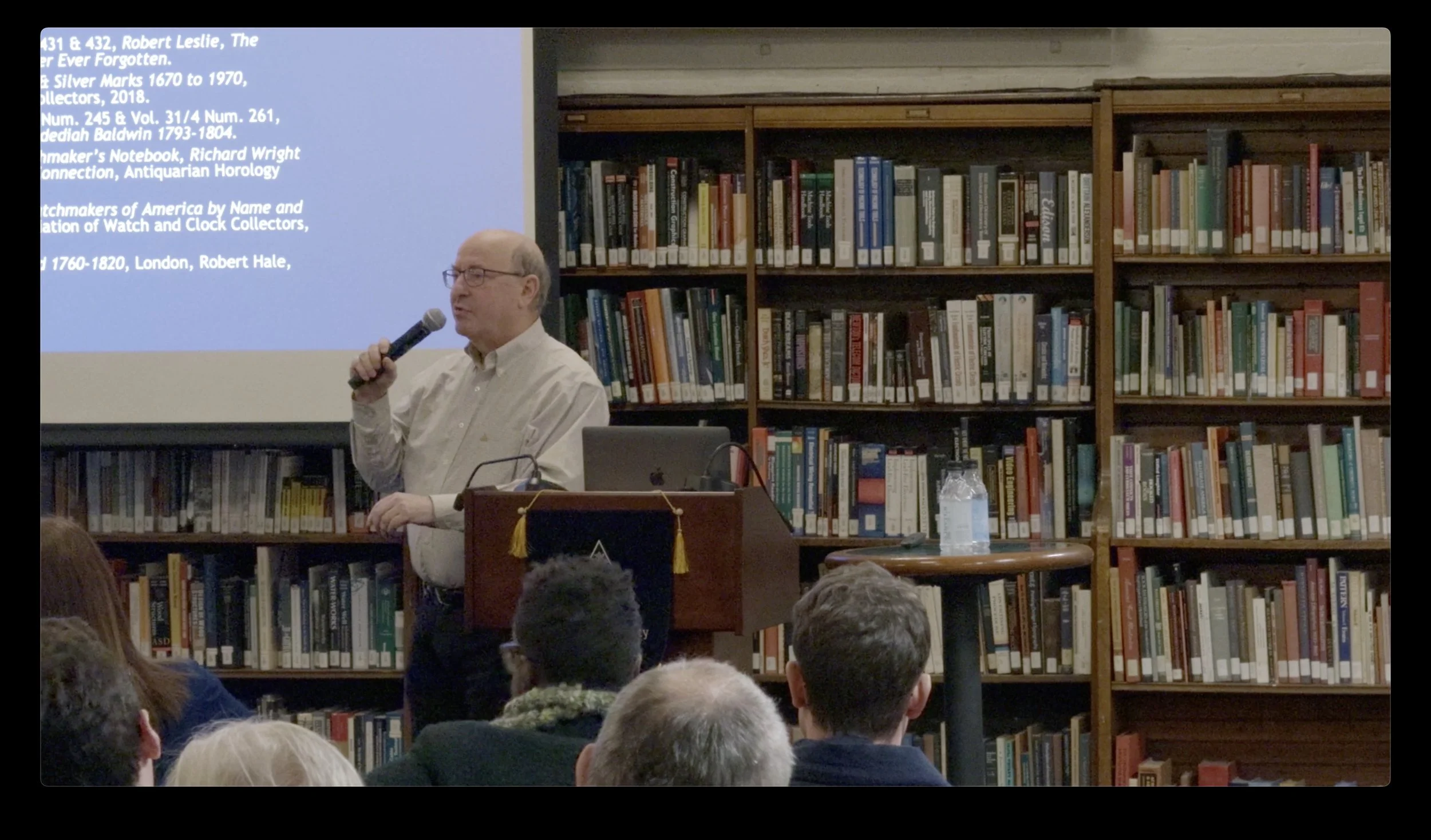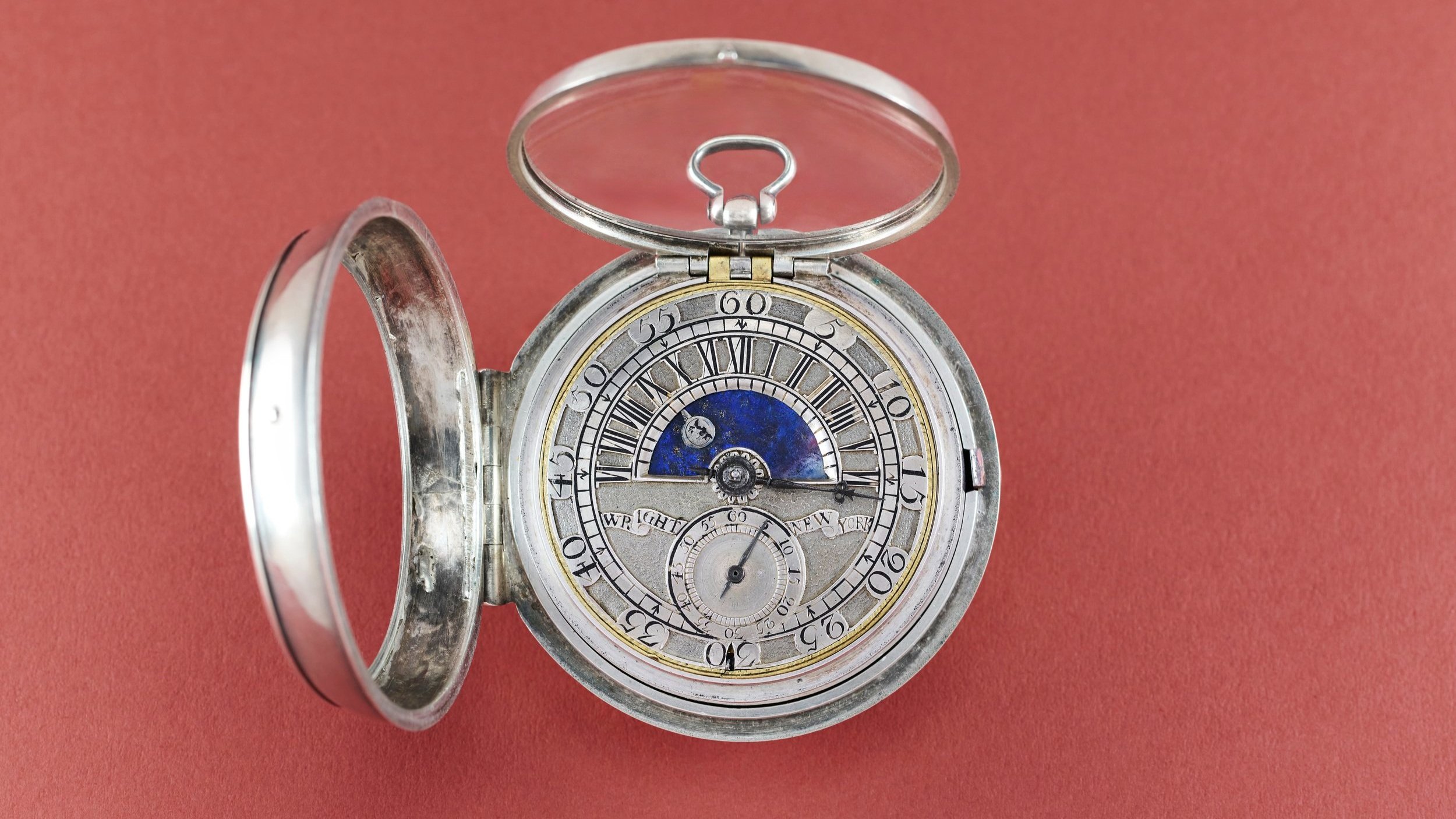

Giving Meaning To Speed: Time and Timing at Brooklands
Video recordings of lectures are available immediately to HSNY members, and the general public with a two-month delay.
Simon Jeffs, Founder, Brooklands Watch Company (United Kingdom)
What is speed without time to measure it?
At the December 2025 lecture of the Horological Society of New York (HSNY), Simon Jeffs, Founder of Brooklands Watch Company, will explore this fundamental question through the remarkable story of Brooklands — the world’s first purpose-built motor racing circuit, where in 1907, timekeepers measured speed within a thousandth of a second — the same precision used in Formula 1 today.
From Percy Lambert’s heroic 100 miles in one hour to John Cobb’s land speed records, from pioneering women racers like Kay Petre to the engineers who understood that “if you can’t measure it, you can’t improve it,”; Brooklands became Britain’s crucible of speed where every victory, every record, every tragedy was defined by the tick of a chronograph.
Jeffs will reveal how this obsession with precision timing connected watchmaking to human ambition, featuring figures from Reid Railton to George Daniels (who once owned the legendary 1929 Birkin Bentley that set Brooklands’ lap record), and trace the journey from mechanical stopwatches wielded by officials dodging flying gravel to the sophisticated timing systems that made motorsport possible. The lecture will culminate with Jeffs’ own connection to this heritage through Sir Terence Conran, whose parents were Brooklands regulars and who designed Brooklands’ debut watch — the British design icon’s only timepiece.
*Doors open at 5:30 PM ET, lecture to begin at 6 PM ET. RSVP is required.
** The lecture video will be available to members immediately, and to the general public following a two-month delay.
About Simon Jeffs
An aero-mechanical systems engineer and aviation entrepreneur, Simon Jeffs founded Brooklands Watch Company in 2017 after discovering the Holden Apparatus—the world’s first motor racing chronograph, accurate to a thousandth of a second in 1907—at Brooklands Museum. He persuaded Sir Terence Conran to design the brands debut Triple-Four Racing Chronograph, the British design icon’s first and only watch design.
Since launching, Brooklands has established itself through its core purpose: “we give meaning to speed,” manifested not only through Swiss-made timepieces but through Simon’s sponsorship of Richard Noble OBE’s Thrust WSH water speed record programme. A defining milestone came when The Jockey Club selected Brooklands as its British watch partner to create the Golden Miller Racing Chronograph, reflecting a historical connection to the Brooklands racetrack.

anOrdain: Our First Decade With Enamel
Video recordings of lectures are available immediately to HSNY members, and the general public with a two-month delay.
Lewis Heath, anOrdain Founder and Designer (Glasgow, Scotland)
Enameling is one of watchmaking’s most captivating decorative arts — an ancient process that fuses powdered glass to metal through intense heat, creating luminous, enduring color. From traditional cloisonné and champlevé to modern interpretations like those utilized at anOrdain, each enamel dial reflects a delicate balance of chemistry, artistry, and patience, where even the smallest imperfection can mean starting anew.
At the November 2025 lecture of the Horological Society of New York (HSNY), Lewis Heath, Founder and Designer of anOrdain, will set out to provide the audience with an understanding of what vitreous, or grand feu enamel is, how it’s done, and the different techniques employed in its production. Heath will also take attendees through his own enduring obsession with enamel, from the coin that started it all, to building a watchmaking factory in Scotland, and the trials and tribulations of building a team around a love of craft along the way.
*Doors open at 5:30 PM ET, lecture to begin at 6 PM ET. RSVP is required.
** The lecture video will be available to members immediately, and to the general public following a two-month delay.
About Lewis Heath
Heath is the founder of Glaswegian watchmaker anOrdain, and the leader of the burgeoning team of skilled craftspeople behind them and sister brand, Paulin. After graduating in Architecture, Heath went into industrial design and created the audio company RHA. Becoming frustrated with the disconnect between design and manufacturing, he founded anOrdain as a hobby, with the idea of design and production being under one roof and within a tight feedback loop.
Outside of horology, Heath lives with his family on a smallholding in the Scottish Highlands, keeps sheep, and tries not to damage himself or others with agricultural machinery which he has little to no idea how to use. He is also an associate member of the All Party Parliamentary Group for Craft, an advisory committee for MPs on heritage craft.
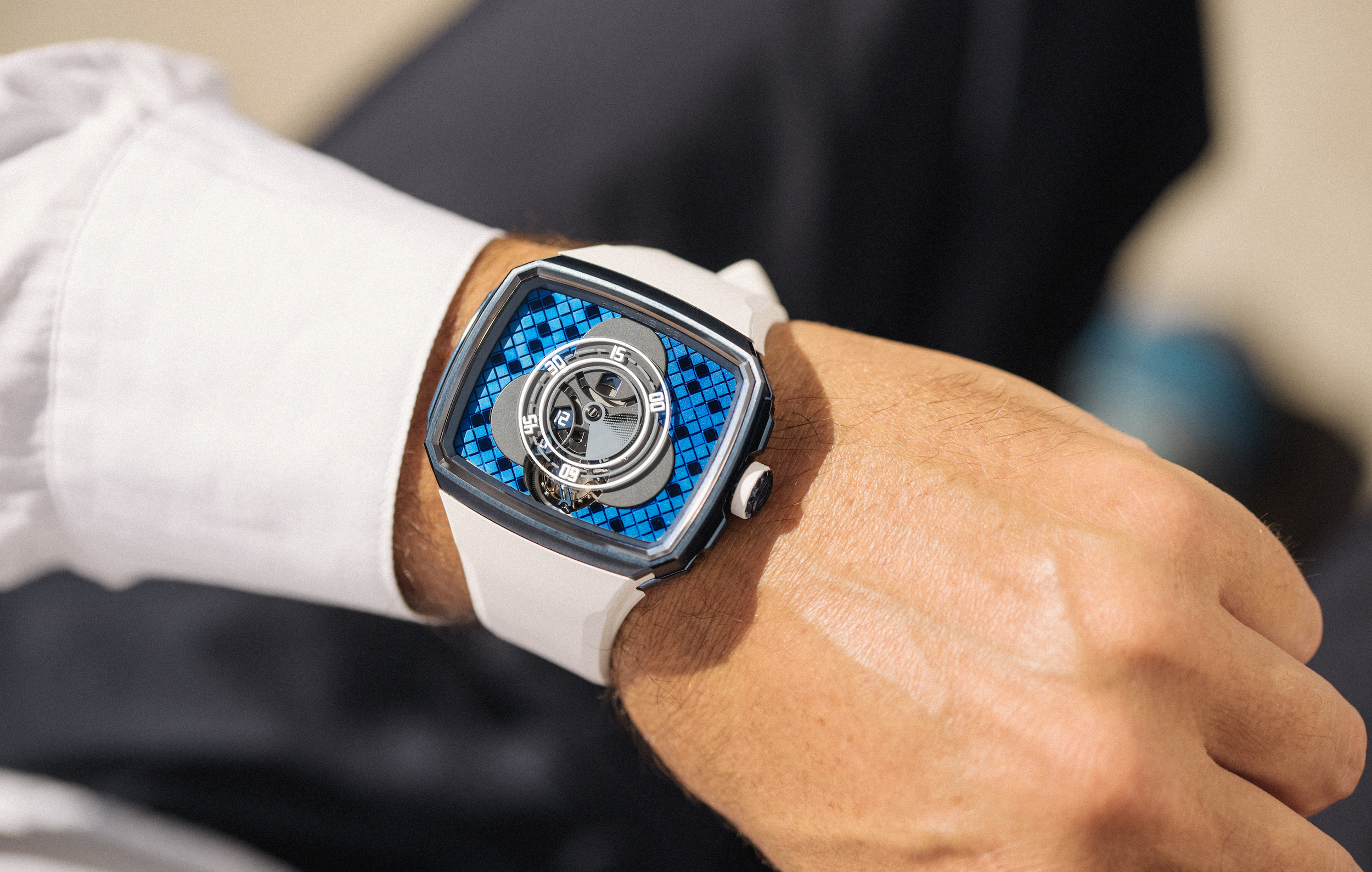
Traditionalists Beware: How Hautlence Built an Independent Brand by Questioning Design and Time Displays
Video recordings of lectures are available immediately to HSNY members, and the general public with a two-month delay.
Guillaume Tetu, Hautlence Founder & Chairman and Cedric Joos, Global Brand Manager (Neuchâtel, Switzerland)
In 2004, Hautlence emerged in Neuchâtel with a bold vision: to redefine how time is displayed.
At the October 2025 lecture of the Horological Society of New York (HSNY), Hautlence Founder & Chairman Guillaume Tetu, and Global Brand Manager Cedric Joos will provide a behind-the-scenes look at building an independent brand during the renaissance of modern watchmaking.
Prepare to dive deep into the full process, from designing, prototyping, and bringing to market innovative and never-before-seen complications. The HL2 with its rotating escapement, the groundbreaking Sphere, and the recently released Retrovision '85 (the famous robot watch), and Helix will be just a few highlights of the evening. Tetu and Joos will conclude the lecture with a few words on what will be coming next for the young and innovative brand.
*Doors open at 5:30 PM ET, lecture to begin at 6 PM ET. RSVP is required.
** The lecture video will be available to members immediately, and to the general public following a two-month delay.
About Guillaume Tetu
Trained in Industrial Design and CAD with multiple roles in the watch industry — from product development and operations to CEO — Guillaume is a serial entrepreneur who co-founded the HAUTLENCE brand in 2004, as well as several other subcontractors or services companies.
With a genuine entrepreneurship spirit and full P&L ownership, Guillaume is also a team player who enjoyed playing American Football and Rugby for 20+ years and he created the Neuchatel Knights team. He is also an epicurean, always ready to share a good meal, wine, or a good cigar.

The Conservation of the Great Clock of Westminster – Big Ben
Video recordings of lectures are available immediately to HSNY members, and the general public with a two-month delay.
Keith Scobie-Youngs, Co-Founder, The Cumbria Clock Company (Cumbria, England)
In 2017, the Great Clock of Westminster—better known as Big Ben—was fully dismantled and removed from the iconic Elizabeth Tower for the first time since its installation in 1859. This unprecedented conservation project, completed in 2022, presented a once-in-a-lifetime opportunity to examine, restore, and future-proof the world’s most famous public timepiece.
At the June 2025 lecture of the Horological Society of New York (HSNY), Keith Scobie-Youngs, co-founder of The Cumbria Clock Company, will share behind-the-scenes of the entire five-year restoration process, from the meticulous disassembly and transportation of the 5.5-ton movement to the intricate conservation techniques employed by his specialist team. Every stage of the project was guided by a deep respect for the clock’s original craftsmanship and a commitment to ensuring its reliable operation for another 160 years and beyond.
Join Scobie-Youngs, lead conservator on the project, as he shares the challenges, discoveries, and triumphs of restoring this remarkable Victorian masterpiece to its full glory.
*Doors open at 5:30 PM ET, lecture to begin at 6 PM ET. RSVP is required.
** The lecture video will be available to members immediately, and to the general public following a two-month delay.
About Keith Scobie-Youngs FBHI ACR
Keith studied Horology at the School of Jewellery and Silversmithing in 1981 and following graduation in 1984, he worked for six years at Public Clocks in London.
In 1990 he established the Cumbria Clock Company Ltd with his wife Lynn, which is situated in the small village of Dacre in the Lake District National Park.
Keith has grown Cumbria Clock Company into a sizeable business, employing 22 members of staff consisting of the office team, the workshop conservators, and external horological engineers.
The Company is responsible for the annual maintenance of over 1,400 church and public clocks situated throughout the UK and has undertaken conservation projects to some of the country’s most prestigious church and public clocks.
Keith’s experience includes working on the country’s oldest clock at Salisbury Cathedral, the Astronomical Clock at Hampton Court Palace, as well as major projects at Canterbury, Durham, Hereford, Gloucester, Worcester, Truro and Manchester Cathedrals, and the Royal Liver Building, Liverpool.
Other commissions include the Westminster Clock, better known as “Big Ben”, where he has been overseeing the biggest conservation works undertaken on the world’s most famous clock.
The company also designed, manufactured, and installed the world’s largest internal bell hammer, which struck the Olympic Bell and started the London 2012 Games, and the conservation of the Government Buildings clock in Fiji.
Other clients include the Royal Household, Historic Royal Palaces, English Heritage, and the National Trust.
Keith was the Master of the Worshipful Company of Clockmakers, London in 2024, is a Director of the Antiquarian Horological Society, Director of the British Watch and Clockmakers Guild, a Fellow of the British Horological Institute, and an ICON Accredited Conservator Restorer and ICON Mentor.

John Harrison and a Clock for All Seasons: The Creation of the Gridiron Pendulum
Video recordings of lectures are available immediately to HSNY members, and the general public with a two-month delay.
Eddie Landzberg, Horologist (New York, New York)
Before creating his famed marine chronometers (1730–59) to determine longitude at sea, John Harrison focused on land-based timekeeping, striving to build pendulum clocks of the highest possible precision. In the years following the Scientific Revolution and on the cusp of the Industrial Revolution, pendulum clocks governed travel, work, and daily life. The United Kingdom’s variable climate posed a special challenge for clock precision: colder air contracted metal pendula while warmer air expanded them, shortening and lengthening the swing period, respectively. In 1726, Harrison invented the gridiron pendulum. By connecting alternating rods of metals such as brass and steel, each with different thermal expansion rates, Harrison’s gridiron compensated for temperature shifts and stabilized the pendulum’s length and period.
At the May 2025 lecture of the Horological Society of New York (HSNY), Eddie Landzberg will present his undergraduate research on John Harrison’s gridiron pendulum. In an independent study at Harvard University, Landzberg examined Harrison’s original manuscripts in London and constructed a brass and steel gridiron pendulum. In his lecture, Landzberg will discuss the scientific discoveries, climate conditions, and horological innovations that set the scene for Harrison’s work. He will further discuss how the gridiron pendulum functions, reflect on its early reception, and share insights from the reproduction process.
*Doors open at 5:30 PM ET, lecture to begin at 6 PM ET. RSVP is required.
** The lecture video will be available to members immediately, and to the general public following a two-month delay.
About Eddie Landzberg
Since a young age, Eddie Landzberg has been fascinated by timekeepers old and new. As a high school student, he interned at the American Clock & Watch Museum in Connecticut, the National Watch and Clock Museum in Pennsylvania, the Museum of Timekeeping in England, and the Royal Observatory Greenwich. Landzberg was inspired by HSNY’s introductory watchmaking courses and enjoys amateur watchmaking and repair during off hours from his work in finance. Landzberg was accepted to the Grand Prix d’Horlogerie de Genève (GPHG) Academy in 2023 and has been featured in The New York Times.

HSNY 2025 Gala
Join Us as We Celebrate 159 Years of New York’s Horological Tradition!
The Horological Society of New York (HSNY), America’s oldest watchmaking guild, founded in 1866, announces today its 159th anniversary Gala, taking place on Saturday, March 22, 2025, at the iconic Plaza Hotel in New York City. This milestone event will bring together top watch brands, horology enthusiasts, industry leaders, and collectors to celebrate the Society’s rich history and its ongoing mission to advance the art and science of horology.
HSNY’s annual Gala is a glamorous evening filled with fine dining, scholarships for watchmaking students, and a live auction showcasing exceptional timepieces.

Retail vs. Reality: How To Get Access to the World’s Hottest Watches (At MSRP)
Video recordings of lectures are available immediately to HSNY members, and the general public with a two-month delay.
Yoni Ben-Yehuda, Head of Watches, Material Good (New York, New York)
The current watch market is in a fascinating state, blending traditional luxury with modern innovation and shifting consumer preferences. To understand how we got here and what the future of watch collecting looks like, especially in the U.S., it’s essential to explore the evolution of the market, the underlying factors shaping it today, and what collectors need to keep in mind when curating their collections in 2025.
At the March 2025 lecture of the Horological Society of New York (HSNY), Yoni Ben-Yehuda, Head of Watches at Material Good, will lecture on the current watch market, its evolution, and what the future of watch collecting may look like. Ben-Yehuda will offer a peek into the inner workings of the watch industry (from the retail perspective) and explore the do’s and don’ts of building a modern watch collection in 2025.
*Doors open at 5:30 PM ET, lecture to begin at 6 PM ET. RSVP is required.
** The lecture video will be available to members immediately, and to the general public following a two-month delay.
About Yoni Ben-Yehuda
As Head of Watches at Material Good, Yoni Ben-Yehuda oversees strategic initiatives related to luxury watch sales and services for all MG enterprises, including partnerships with select branded boutiques across the United States.
Yoni has played a pivotal role in some of the most notable sales of both vintage and modern grail watches, showcasing a deep understanding of the market and collector needs. He serves as an executor for estates belonging to prominent watch collectors, ensuring that valuable pieces are managed and preserved appropriately. Yoni has been instrumental in designing timepieces for prestigious brands like Audemars Piguet and Cartier, with additional projects currently in development. With over a decade of experience in marketing, Yoni has worked across various industries, including healthcare IT, entertainment, and luxury goods, adding a diverse skill set to his profile. He has served as an advisor of a social entrepreneurship independent study program at The Wharton School, illustrating his commitment to education and mentorship.

Fundamentals of Luxury Watchmaking Craftsmanship
Video recordings of lectures are available immediately to HSNY members, and the general public with a two-month delay.
François Perez, Technical Director and Movement Constructor at Biver (Givrins, Switzerland)
What does it take to create a timepiece that transcends mere function and becomes a work of art? How do watchmakers incorporate elements of design and aesthetics into their creations? And what specific skills and techniques are necessary to elevate a watch from a simple tool to an object of beauty and wonder?
With a career distinguished by multiple world records in horological innovation, François Perez, Technical Director and Movement Constructor at Biver, draws on both his personal achievements and the brand's meticulous approach to advance the art and science of horology.
At the February 2025 lecture of the Horological Society of New York (HSNY), Perez will discuss the processes that transform raw materials into exceptional mechanical timepieces. Attendees will gain a deeper understanding of the craftsmanship involved in creating high-end watches at Biver, as well as the careful balance between preserving traditional techniques and embracing modern advancements.
*Doors open at 5:30 PM ET, lecture to begin at 6 PM ET. RSVP is required.
** The lecture video will be available to members immediately, and to the general public following a two-month delay.
About François Perez
François Perez (1988) was born in Paris and began his schooling at the École Alsacienne in Paris, later attending the Lycée Saint-Denis in Loches, where he earned a scientific baccalaureate with honors. He then moved to Switzerland to attend the Haute École Arc Ingénierie in Le Locle, pursuing his passion for precision engineering. There, he earned a bachelor’s degree in microtechnology and watchmaking engineering, with a specialization in watch construction and complications.
In 2012, after completing his schooling, François joined Concepto Watch Factory, one of Switzerland’s premier movement developers and manufacturers. He spent the next decade at Concepto creating no fewer than 36 unique movements and setting three world records in the process. Among his creations are the Datora for Breitling, the Tourbillon Chronograph (WR), Finissimo Ultra, and Finissimo Ultra COSC (WR) for Bvlgari, the Bugatti Chiron for Jacob & Co., the Maximus (WR) for Kerbedanz, and the Memoris and Tourbillon Chronograph Memoris for Louis Moinet. These creations, among others, earned François a reputation for pushing boundaries and achieving technical excellence across the Swiss watch industry.
François joined Biver as Technical Director in 2022, overseeing the technical office and managing the setup, recruitment, and development of the brand’s watchmaking and decoration workshops, as well as handling logistical operations. He has overseen the development and creation of all Biver watches since the company’s inception and continues to work on new in-house Biver calibers, ensuring the brand’s continued success and growth. Every watch that leaves the Biver workshop passes under his careful eye before it reaches a customer’s wrist.

Early American Pocket Watches
Video recordings of lectures are available immediately to HSNY members, and the general public with a two-month delay.
Richard Newman, Antiquarian Horologist (DeKalb, Illinois)
A watch was one of the most expensive consumer goods that one could buy in early America. They were a technical mystery that embodied the very height of craftsmanship, fashion, and artistry in the world, and conveyed one’s stature in society.
At the January 2025 lecture of the Horological Society of New York (HSNY), Antiquarian Horologist Richard Newman will introduce “Early American Pocket Watches,” HSNY’s latest exhibit that spans 125 years of American watchmaking. From the earliest known American-signed watch, made in about 1715, to watches made during the early Federal period after the War of Independence, Newman will take us on a journey through the beginnings of an era that laid the foundations for the American watch industry.
*Doors open at 5:30 PM ET, lecture to begin at 6 PM ET. RSVP is required.
** The lecture video will be available to members immediately, and to the general public following a two-month delay.
About Richard Newman
Richard Newman is Chair Emeritus and a Star Fellow of the National Association of Watch and Clock Collectors (NAWCC), Freeman of the Worshipful Company of Clockmakers, and a Director of the American Clock & Watch Museum. He currently leads NAWCC’s British Horology Chapter and the USA Section of the Antiquarian Horology Society based in London. Newman has lectured and published articles on early clocks and watches in the U.S. and abroad and hosts a website on early watchmakers, colonialwatches.com, to promote research and education.
